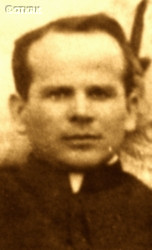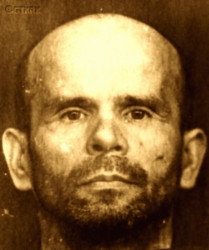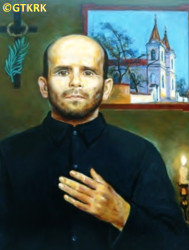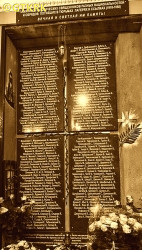Roman Catholic
St Sigismund parish
05-507 Słomczyn
85 Wiślana Str.
Konstancin deanery
Warsaw archdiocese, Poland
full list:
displayClick to display full list

searchClick to search full list by categories
wyświetlKliknij by wyświetlić pełną listę po polsku

szukajKliknij by przeszukać listę wg kategorii po polsku

Martyrology of the clergy — Poland
XX century (1914 – 1989)
personal data
religious status
Servant of God
surname
CHOMICZ
forename(s)
Paul (pl. Paweł)
function
diocesan priest
creed
Latin (Roman Catholic) Church RCmore on
en.wikipedia.org
[access: 2014.09.21]
diocese / province
Mogilev archdiocesemore on
en.wikipedia.org
[access: 2013.06.23]
date and place
of death
10.09.1942

Sankt Petersburgtoday: Saint Petersburg city, Russia
more on
en.wikipedia.org
[access: 2020.07.31]
details of death
For the first time arrested by the Russians on 02.12.1926 in Saint Petersburg.
Soon released, but on 28.01.1927 arrested again.
Accused of „conducting counter–revolutionary religious activity among young people and parishioners as well as creating an illegal anti–Russian fraternity of members of the Third Order of the Franciscans” and „counter–revolutionary agitation among workers”.
On 27.06.1927, sentenced by the murderous Russian OGPU kangaroo court to 10 years of forced slave labor (initially the prosecutor's office demanded three years' imprisonment, but the „court” decided otherwise).
On 03.08.1927 transported to the ITL SLON concentration camp on the Solovetsky Islands.
In 06.1929 transported to the concentration camp „Troitskaya” on the Anzer island in the same region.
There, on 05.07.1932, tried in a trial against already imprisoned Catholic priests on charges of „establishing an anti–Russian group among prisoners” and celebrating secret Holy Masses.
On 21.07.1932 transported to the Russian murderous OGPU „Shpalerka” prison at Voynova Str. in Sankt Petersburg.
Tortured.
On 25.04.1933 transferred to another prison in Saint Petersburg.
On 27.05.1933 sentenced by a murderous OGPU court to a year in strict isolation.
Held in ITL SvirLag concentration camp, near Lodeynoye Polye.
In 08.1933 sent to Komsomolsk–on–Amur to slave labor in felling the forest.
At the end of 1933, due to ill health, prob. taken to hospital for neurological patients in Sankt Petersburg.
From there prob. in 08.1935 transported back to concentration camp in Solovetsky Islands.
10.11.1936 released, but forbidden to enter big Russian cities.
Initially settled in Ufa, then in Vitebsk, Irkutsk, Kostroma and Kaluga.
In 08.1939 illegally returned to Sankt Petersburg, where continued to serve clandestinely.
After the German and Russian invasions of Poland in 09.1939 and the start of World War II, after the German attack in 06.1941 of their former ally, the Russians, arrested by the Russians on 15.06.1942 during the blockade of Saint Petersburg — already in the role of the apostolic administrator of Sankt Petersburg.
Accused of „organizing a clandestine church, anti–Russian and defeatist agitation and slander against the Russian authorities”.
On 01.09.1941, sentenced to death by the Russian Military Genocide Tribunal of the NKVD.
Murdered in prison — shot.
cause of death
murder
perpetrators
Russians
sites and events
Sankt Petersburg (Kresty)Click to display the description, Ribbentrop‐MolotovClick to display the description, Pius XI's encyclicalsClick to display the description, Forced exileClick to display the description, ITL SvirLagClick to display the description, Trial of 05.07.1932Click to display the description, ITL SLONClick to display the description, GulagClick to display the description
date and place
of birth
29.10.1893

Vawkavysktoday: Vawkavysk dist., Grodno reg., Belarus
more on
en.wikipedia.org
[access: 2022.01.06]
alt. dates and places
of birth
17.10.1893
parents
CHOMICZ Simon
🞲 ?, ? — 🕆 ?, ?

ZUDELEWICZ Marianne
🞲 ?, ? — 🕆 ?, ?
presbyter (holy orders)
ordination
1916

positions held
1941 – 1942
apostolic administrator — Sankt Petersburg RC Apostolic Administration — acting („ad interim”); formal apostolic administrator, Bp Maurice John Baptist Amoudru, was expelled from Russia by communists in 1935
from 1923
parish priest — Sankt Petersburgtoday: Saint Petersburg city, Russia
more on
en.wikipedia.org
[access: 2020.07.31] ⋄ St Casimir („behind Narva Tollgate”) RC parish ⋄ Sankt Petersburgtoday: Saint Petersburg city, Russia
more on
en.wikipedia.org
[access: 2020.07.31] RC deanery
1925 – 1926
administrator — Kronstadttoday: part of Sankt Petersburg, Saint Petersburg city, Russia
more on
en.wikipedia.org
[access: 2022.01.06] ⋄ St Peter and St Paul the Apostles RC parish ⋄ Sankt Petersburgtoday: Saint Petersburg city, Russia
more on
en.wikipedia.org
[access: 2020.07.31] RC deanery
c. 1923 – 1926
administrator — Petergoftoday: Petrodvortsovy reg., Saint Petersburg city, Russia
more on
en.wikipedia.org
[access: 2022.07.16] ⋄ St Alex RC church ⋄ Sankt Petersburgtoday: Saint Petersburg city, Russia
more on
en.wikipedia.org
[access: 2020.07.31] RC deanery
c. 1923 – 1926
administrator — Ligovotoday: Ulitsky okruh, Krasnoselsky District in Sankt Petersburg, Saint Petersburg city, Russia
more on
en.wikipedia.org
[access: 2022.05.23] ⋄ Our Lady of Częstochowa RC church ⋄ Sankt Petersburgtoday: Saint Petersburg city, Russia
more on
en.wikipedia.org
[access: 2020.07.31] RC deanery
1920 – 1923
vicar — Pskovtoday: Pskov city reg., Pskov oblast, Russia
more on
en.wikipedia.org
[access: 2022.07.16] ⋄ Holy Trinity RC parish ⋄ Sankt Petersburgtoday: Saint Petersburg city, Russia
more on
en.wikipedia.org
[access: 2020.07.31] RC deanery — ministered also in filial chapels in Ostriv and Opochka, and also in Dno and Porkhov
1918 – 1920
vicar — Vyritsatoday: Vyritsa urban, Gatczyna reg., Leningrad oblast, Russia
more on
en.wikipedia.org
[access: 2022.06.16] ⋄ St Joseph RC chapel ⋄ Sankt Petersburgtoday: Saint Petersburg city, Russia
more on
en.wikipedia.org
[access: 2020.07.31] RC deanery — ministered also in other chapels of railway lines: Dno station on Kiev line (from 1919), and Cholovo and Staraya Russa stations on Moscow line (from 1920)
c. 1918
vicar — Sankt Petersburgtoday: Saint Petersburg city, Russia
more on
en.wikipedia.org
[access: 2020.07.31] ⋄ RC parish
1915 – 1918
student — Sankt Petersburgtoday: Saint Petersburg city, Russia
more on
en.wikipedia.org
[access: 2020.07.31] ⋄ philosophy and theology, Imperial Roman Catholic Spiritual Academy (1842‐1918)
till 1915
student — Sankt Petersburgtoday: Saint Petersburg city, Russia
more on
en.wikipedia.org
[access: 2020.07.31] ⋄ philosophy and theology, Metropolitan Theological Seminary
sites and events
descriptions
Sankt Petersburg (Kresty): Russian prison in Sankt Petersburg where many Polish priests were kept captive. Many of them were also murdered there. (more on: en.wikipedia.orgClick to attempt to display webpage
[access: 2014.12.20])
Ribbentrop‐Molotov: Genocidal Russian‐German alliance pact between Russian leader Joseph Stalin and German leader Adolf Hitler signed on 23.08.1939 in Moscow by respective foreign ministers, Mr. Vyacheslav Molotov for Russia and Joachim von Ribbentrop for Germany. The pact sanctioned and was the direct cause of joint Russian and German invasion of Poland and the outbreak of the World War II in 09.1939. In a political sense, the pact was an attempt to restore the status quo ante before 1914, with one exception, namely the „commercial” exchange of the so‐called „Kingdom of Poland”, which in 1914 was part of the Russian Empire, fore Eastern Galicia (today's western Ukraine), in 1914 belonging to the Austro‐Hungarian Empire. Galicia, including Lviv, was to be taken over by the Russians, the „Kingdom of Poland” — under the name of the General Governorate — Germany. The resultant „war was one of the greatest calamities and dramas of humanity in history, for two atheistic and anti‐Christian ideologies — national and international socialism — rejected God and His fifth Decalogue commandment: Thou shall not kill!” (Abp Stanislav Gądecki, 01.09.2019). The decisions taken — backed up by the betrayal of the formal allies of Poland, France and Germany, which on 12.09.1939, at a joint conference in Abbeville, decided not to provide aid to attacked Poland and not to take military action against Germany (a clear breach of treaty obligations with Poland) — were on 28.09.1939 slightly altered and made more precise when a treaty on „German‐Russian boundaries and friendship” was agreed by the same murderous signatories. One of its findings was establishment of spheres of influence in Central and Eastern Europe and in consequence IV partition of Poland. In one of its secret annexes agreed, that: „the Signatories will not tolerate on its respective territories any Polish propaganda that affects the territory of the other Side. On their respective territories they will suppress all such propaganda and inform each other of the measures taken to accomplish it”. The agreements resulted in a series of meeting between two genocidal organization representing both sides — German Gestapo and Russian NKVD when coordination of efforts to exterminate Polish intelligentsia and Polish leading classes (in Germany called «Intelligenzaktion», in Russia took the form of Katyń massacres) where discussed. Resulted in deaths of hundreds of thousands of Polish intelligentsia, including thousands of priests presented here, and tens of millions of ordinary people,. The results of this Russian‐German pact lasted till 1989 and are still in evidence even today. (more on: en.wikipedia.orgClick to attempt to display webpage
[access: 2015.09.30])
Pius XI's encyclicals: Facing the creation of two totalitarian systems in Europe, which seemed to compete with each other, though there were more similarities than contradictions between them, Pope Pius XI issued in 03.1937 (within 5 days) two encyclicals. In the „Mit brennender Sorge” (Eng. „With Burning Concern”) published on 14.03.1938, condemned the national socialism prevailing in Germany. The Pope wrote: „Whoever, following the old Germanic‐pre‐Christian beliefs, puts various impersonal fate in the place of a personal God, denies the wisdom of God and Providence […], whoever exalts earthly values: race or nation, or state, or state system, representatives of state power or other fundamental values of human society, […] and makes them the highest standard of all values, including religious ones, and idolizes them, this one […] is far from true faith in God and from a worldview corresponding to such faith”. On 19.03.1937, published „Divini Redemptoris” (Eng. „Divine Redeemer”), in which criticized Russian communism, dialectical materialism and the class struggle theory. The Pope wrote: „Communism deprives man of freedom, and therefore the spiritual basis of all life norms. It deprives the human person of all his dignity and any moral support with which he could resist the onslaught of blind passions […] This is the new gospel that Bolshevik and godless communism preaches as a message of salvation and redemption of humanity”… Pius XI demanded that the established human law be subjected to the natural law of God , recommended the implementation of the ideal of a Christian state and society, and called on Catholics to resist. Two years later, National Socialist Germany and Communist Russia came together and started World War II. (more on: www.vatican.vaClick to attempt to display webpage
[access: 2023.05.28], www.vatican.vaClick to attempt to display webpage
[access: 2023.05.28])
Forced exile: One of the standard Russian forms of repression. The prisoners were usually taken to a small village in the middle of nowhere — somewhere in Siberia, in far north or far east — dropped out of the train carriage or a cart, left out without means of subsistence or place to live. (more on: en.wikipedia.orgClick to attempt to display webpage
[access: 2014.12.20])
ITL SvirLag: Russian Rus. Исправи́тельно‐Трудово́й Ла́герь (Eng. Corrective Labor Camp) ITL Rus. Свирьский (Eng. Svirskiy) — concentration and slave forced labor camp (within the Gulag complex) — headquartered in Lodeynoye Polye in Sankt Petersburg Oblast. Founded on 17.09.1931, on the basis of subcamps No. 9 and 10 of the ITL SLON concentration camp on the Solovetsky Islands, encompassing former Alexander Svirsky monastery among others. Prisoners slaved at the forest clearing and obtaining firewood destined for Sankt Petersburg, c. 240 km away, in sawmills, wood processing plants, in civil and railway construction, in mica and stone mines, in clay mining, in agricultural work and in the production of consumer goods, etc. At its peak c. 48,000 prisoners were held there: e.g. 47,400 (12.1932); 43,770 (01.01.1934); 40,761 (01.01.1935); 44,273 (01.06.1935); 34,856 (01.01.1936); 22,774 (01.01.1937). Among them were many political and religious prisoners. Many were shot within the camp during the so‐called The Great Purge of 1937‐1938. Formally ceased operations in c. 07.1937. (more on: old.memo.ruClick to attempt to display webpage
[access: 2024.04.08])
Trial of 05.07.1932: Russian trial of Catholic priests held in Solovetsky Islands and Anzer Island, accused of „creation of an anti‐Russian group that conducted anti‐Russian agitation, clandestinely celebrated Mass and religious rites and maintained an illegal contact with a free worker for purposes of transmitting abroad information of an espionage character about the situation of Catholics in the Russia”. The prisoners were given prolonged sentences in concentration camp and spread them among the various Gułag camps.
ITL SLON: Russian Rus. Исправи́тельно‐Трудово́й Ла́герь (Eng. Corrective Labor Camp) ITL Rus. Солове́цкий ла́герь осо́бого назначе́ния Ла́герь (Eng. Solovetsky Special Purpose Camp) SLON — concentration and slave forced labor camp (within what was to become Gulag complex) — headquartered in Solovetsky Islands in Arkhangelsk Oblast. Founded on 13.10.1923 in a famous Orthodox monastery. In the 1920s, one of the first and largest concentration camps in Russia. The place of slave labor of prisoners — at forest felling, sawmills, peat extraction, fishing, loading work on the Murmansk Railway Main Line, in road construction, production of food and consumer goods, at the beginning of the construction of the White Sea ‐ Baltic canal, etc. The concept of the later system of Russian Gulag concentration camps prob. had its origins in the Solovetsky Islands camp — from there the idea spread to the camps in the area covered by the construction of the White Sea ‐ Baltic canal, i.e. ITL BelBaltLag, and from there further, to the entire territory of the Russian state. From the network of camps on the Solovetsky Islands — also called the Solovetsky Islands archipelago — prob. also comes the concept of the „Gulag Archipelago” created by Alexander Solzhenitsyn. It is estimated that tens to hundreds of thousands of prisoners passed through the Solovetsky Islands concentration camps. At its peak, c. 72,000 prisoners were held there: e.g. 14,810 (12.1927); 12,909 (03.1928); 65,000 (1929); 53,123 (01.01.1930); 63,000 (01.06.1930); 71,800 (01.01.1931); 15,130 (1932); 19,287 (1933) — c. 43,000 of whom were murdered, including the years 1937‐1938 when c. 9,500 prisoners were transported from the camp and murdered in several places of mass executions, including Sandarmokh, Krasny Bor and Lodeynoye Polye. Among them were many Catholic and Orthodox priests. After the National Socialist Party came to power in Germany in 1933, a German delegation visited the ITL SLON camp, to „inspect” Russian solutions and adopt them later in German concentration camps. It operated until 04.12.1933, with a break from 16.11.1931 to 01.01.1932, when it was part of and later became a subcamp of the ITL BelBaltLag camp. It operated as such until 1939 (from 1936 as a prison). (more on: old.memo.ruClick to attempt to display webpage
[access: 2024.04.08])
Gulag: The acronym Gulag comes from the Rus. Главное управление исправительно‐трудовых лагерей и колоний (Eng. Main Board of Correctional Labor Camps). The network of Russian concentration camps for slave labor was formally established by the decision of the highest Russian authorities on 27.06.1929. Control was taken over by the OGPU, the predecessor of the genocidal NKVD (from 1934) and the MGB (from 1946). Individual gulags (camps) were often established in remote, sparsely populated areas, where industrial or transport facilities important for the Russian state were built. They were modeled on the first „great construction of communism”, the White Sea‐Baltic Canal (1931‐1932), and Naftali Frenkel, of Jewish origin, is considered the creator of the system of using forced slave labor within the Gulag. He went down in history as the author of the principle „We have to squeeze everything out of the prisoner in the first three months — then nothing is there for us”. He was to be the creator, according to Alexander Solzhenitsyn, of the so‐called „Boiler system”, i.e. the dependence of food rations on working out a certain percentage of the norm. The term ZEK — prisoner — i.e. Rus. заключенный‐каналоармец (Eng. canal soldier) — was coined in the ITL BelBaltLag managed by him, and was adopted to mean a prisoner in Russian slave labor camps. Up to 12 mln prisoners were held in Gulag camps at one time, i.e. c. 5% of Russia's population. In his book „The Gulag Archipelago”, Solzhenitsyn estimated that c. 60 mln people were killed in the Gulag until 1956. Formally dissolved on 20.01.1960. (more on: en.wikipedia.orgClick to attempt to display webpage
[access: 2024.04.08])
sources
personal:
www.katolicy.euClick to attempt to display webpage
[access: 2021.12.19], pl.catholicmartyrs.orgClick to attempt to display webpage
[access: 2013.06.23], biographies.library.nd.eduClick to attempt to display webpage
[access: 2014.12.20], pl.wikipedia.orgClick to attempt to display webpage
[access: 2019.02.02]
bibliographical:
„Fate of the Catholic clergy in USSR 1917‐1939. Martyrology”, Roman Dzwonkowski, SAC, ed. Science Society KUL, 2003, Lublin
original images:
pl.catholicmartyrs.orgClick to attempt to display webpage
[access: 2013.06.23], pl.catholicmartyrs.orgClick to attempt to display webpage
[access: 2013.06.23], krzysztofpozarski.files.wordpress.comClick to attempt to display webpage
[access: 2019.04.16], ipn.gov.plClick to attempt to display webpage
[access: 2019.02.02]
LETTER to CUSTODIAN/ADMINISTRATOR
If you have an Email client on your communicator/computer — such as Mozilla Thunderbird, Windows Mail or Microsoft Outlook, described at WikipediaPatrz:
en.wikipedia.org, among others — try the link below, please:
LETTER to CUSTODIAN/ADMINISTRATORClick and try to call your own Email client
If however you do not run such a client or the above link is not active please send an email to the Custodian/Administrator using your account — in your customary email/correspondence engine — at the following address:

giving the following as the subject:
MARTYROLOGY: CHOMICZ Paul
To return to the biography press below:
 Click to return to biography
Click to return to biography











